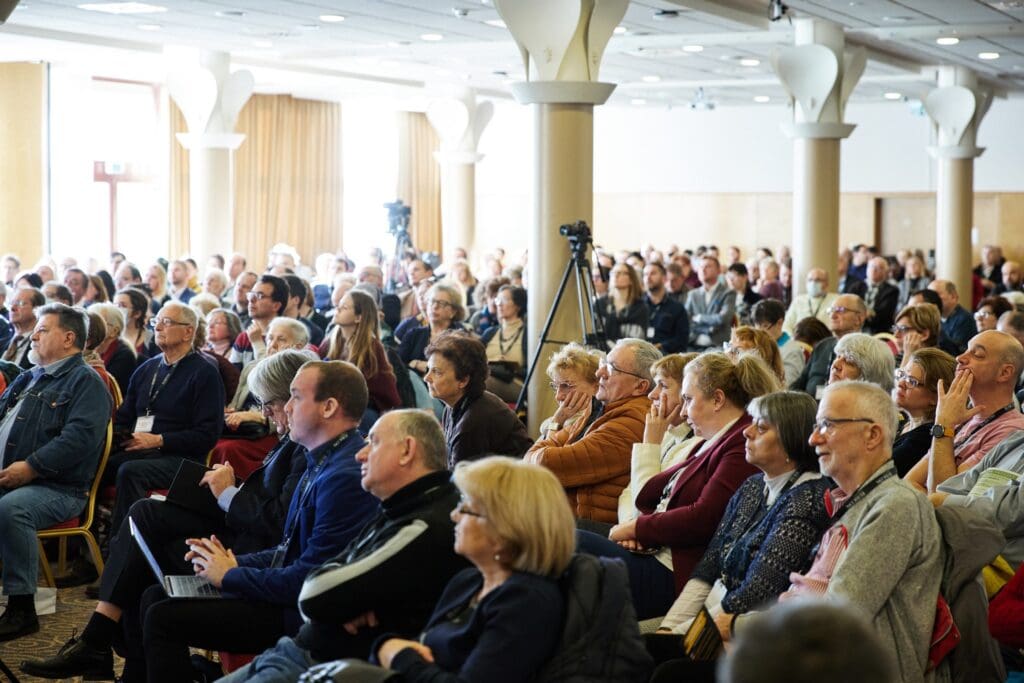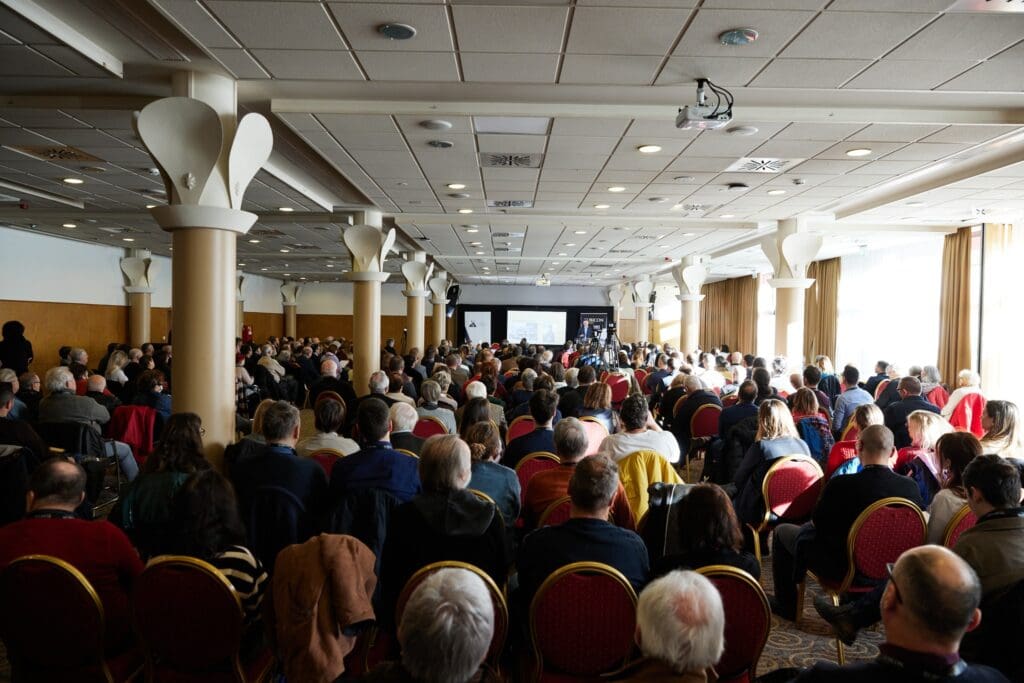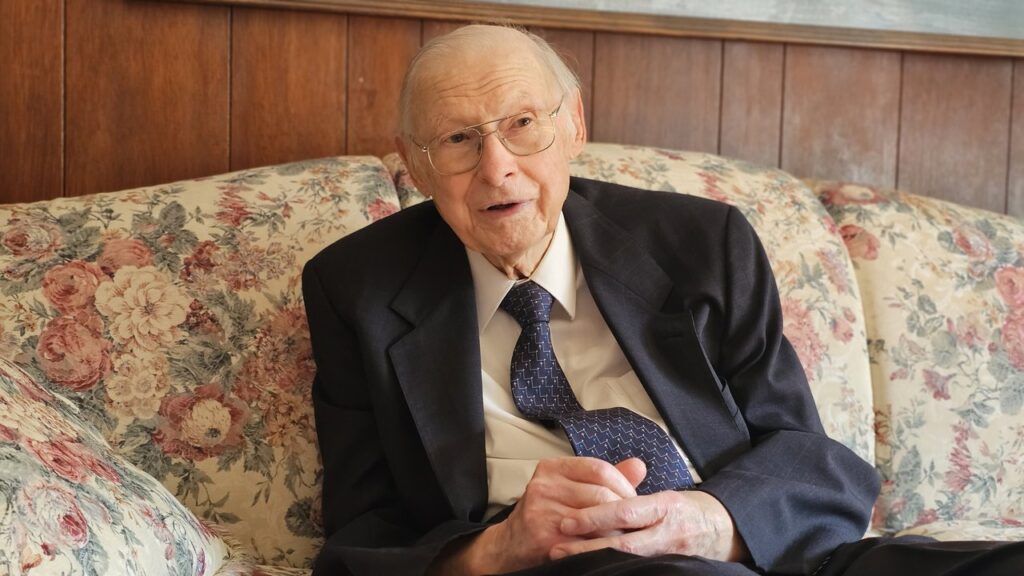The MCC Research Centre’s Auditorium was packed to the brim for the Rubicon Institute event organized on the history of Arab–Israeli conflicts and relations on 27 January.
Arab States After The First World War
Historian and professor at Szeged University Péter Ákos Ferwagner was the first lecturer, speaking about the circumstances surrounding the creation of Arab states after World War I. Much like in Central Europe, the First World War marked the end of the old world and the beginning of a new era in the Middle East. A complete political reordering occurred here as well, giving rise to new states and borders. The conflict accompanied the extension of European influence over the region, although the main directions of this influence were already clear before 1914. However, while before the war, European powers were content with strengthening their influence, after 1918, with the introduction of the mandate system, direct supervision of the Middle East was implemented. Ferwagner highlighted the key milestones of this process in his presentation. He emphasized that in 1917, when the Brits occupied Palestine, the Hungarian artillery was also deployed in the battles of Gaza, playing a significant role in the outcome of the conflicts.

At the end of the presentation he underscored that the First World War and the subsequent settlements were crucial from the perspective of today’s issues,
as they laid the foundations for conflicts that resurfaced later, whether after the Second World War or even in the present day.
The Jewish State After The Second World War
Historian Károly Dobos, lecturer at Pázmány Péter Catholic University and the Central Rabbinical Seminary, presented the process leading to the establishment of the Jewish state. He stressed that there are two perspectives when one looks at these events and it is hard to figure out which side is in the right. In his lecture, he traced the events from the first Aliyah (immigration wave) starting in 1882 to the proclamation of the State of Israel on 14 May, 1948. The focus of the presentation was on the most important political and social issues during the Ottoman Empire and the Palestinian British Mandate period. Understanding these issues provided the audience with a nuanced view of the historical roots of the current conflict.
He discussed that until 1920, Palestine was part of the Ottoman Empire and was a backward area with mainly villages and little trade. The problems of this poor and underdeveloped territory began with Jewish immigration. These Jews used to live in Europe, including millions in Eastern Europe, but their living conditions became increasingly difficult. Antisemitism strengthened, and regular pogroms were carried out in Russia. As a result, 2.5 million Jews emigrated from the area. It was during this time that Jewish national thinking (Zionism) emerged. Theodor Herzl formulated the idea of building a Jewish state, although at that time, no one knew where it would be.
From 1920, Palestine became a territory under British mandate. The goal was for the British to help the territory catch up in every aspect. Economic development began, but the indigenous population felt threatened. A parallel society was formed: Jewish parties, a shadow government, and educational institutions were created. The wealthy Jewish population started to acquire land.
The problems only continued in 1939, when The White Paper policy paper was issued by the British government, in which the Brits attempted to limit migration and land acquisition. Protests broke out in the area in response to the Paper. It came at an increasingly unfortunate time as during the Second World War, the Jews fleeing from the Holocaust started a second wave of migration, however, this time they had to do it illegally. In response, the United Nations partitioned the territory into Jewish and Arab states in November 1947. Although the idea was sound, there was no one to implement it. Thus, a de facto civil war broke out. A series of conflicts ensued until the declaration of independence of Israel in May 1948. The problems did not end there; a day later, five Arab states launched an attack against Israel, today known the War of Independence.
Jabotinsky And His Influence On Political Thinkers of Israel
Historian László Bernát Veszprémy, chief editor of Corvinák and regular contributor of Hungarian Conservative, spoke about the ‘Iron Wall’ and the politics of Jewish power in the Holy Land. As he pointed out, despite numerous significant successes for the 76-year-old State of Israel, its conflict with the Palestinians and the Arab world has cast a long shadow over its history.
Israel’s approach to Arabs is defined by the ‘Iron Wall’ strategy.
The essence is coping with Arabs from an invulnerable position of power.
The concept’s father is Vladimir Ze’ev Jabotinsky, a Russian Jewish writer, Zionist leader, and founder of the Israeli right. Jabotinsky argued in his essay of the same name that two nations want the same land, making the conflict irreconcilable. He believed that the Arabs must be militarily defeated first, and only then can negotiations for peace begin.
He added that although Jabotinsky wrote extensively on ethical issues, he also held more radical views. He wrote about the possibility of relocating Arabs from the territory if they were ‘paid enough’, and he believed that it should be mainly wealthy American Jews to finance this operation. Veszprémy also added that even though Jabotinsky was a so-called reivionist Zionist and right-wing thinker, the left adopted many of his views. As an example, he mentioned that Ben-Gurion, who, while seeing Jabotinsky as an opponent, shared many of his ideas. Veszprémy also highlighted that the most public spaces in Israel are named after Jabotinsky, and Prime Minister Netanyahu often quotes him in his speeches, has extensively read Jabotinsky’s publications, and has even displayed his sword in his office.
The ‘Iron Wall’ was intended to pave the way for a phase where Israel would be strong enough to negotiate lasting peace with its neighbours. Nowadays, achieving this goal seems particularly elusive, the historian noted.

Veszprémy also published an article detailing this topic in Hungarian Conservative.
The Three Arab-Israeli Wars
Tamás Magyarics, university professor, historian, former diplomat and editor-in-chief of Hungarian Conservative presented the Arab-Israeli wars. The international background of the Arab–Israeli wars, especially the American–Soviet rivalry in the Middle East, was the central theme of the presentation.
The uniqueness and essence of the 1956 Suez Crisis lies in the American and British–French conflicts, within the context of Washington’s anti-colonialist policy dating back to World War II, he argued. In 1956 Egypt nationalized the Suez Canal, planning to control the Nile and boost its economy; seeing this, Israel anticipated a threat and launched a pre-emptive war, expecting British and French intervention. The US was caught off guard by the lack of communication with the UK and France and pressured them to withdraw, which marked a shift in the US’s Middle East commitment. As a result, the Eisenhower Doctrine was issued in 1957, aiming to protect the Middle East from Soviet influence.
The Six-Day War in 1967 marked the failure of Gamal Abdel Nasser’s pan-Arab aspirations and the definitive commitment of the United States to Israel in the Middle East. Tensions escalated following Soviet arms shipments in 1964, raising concerns about proxy-war escalation. The war marked a turning point, resulting in the closure of the Tiran Strait and the emergence of a biblical-nationalist stance in Israel. Israel gained territory, bringing one million Arabs under its authority. Following the conflict, UN Resolution 242 called for Israel’s withdrawal from occupied territories,
with disparities in the French and English texts, not making it clear whether they have to withdraw from only some territories they recently occupied, or all of them.
A common feature of the three Israeli–Arab wars is that they can be seen as proxy wars at a certain level, the historian stated.
During the 1973 Yom Kippur War, on the other hand, there was already a moment of direct confrontation between the United States and the Soviet Union, along with the danger of a nuclear war. Arab countries attacked Israel on 6 October, exploiting the Jewish state’s vulnerabilities. The US President, Richard Nixon, preoccupied with the unfolding Watergate scandal, delegated the resolution of the situation to Henry Kissinger, who agreed to an airlift and arms deliveries to Israel. Kissinger’s diplomacy helped de-escalate tensions and restrain the states influenced by the two superpowers.
The Shifting Dynamics of the Palestinian Issue
László Tüske, former director of the National Széchényi Library, delivered a presentation on the Palestinian issue. He emphasized that the Palestinian question has been a focal point of geopolitical tension and conflict throughout the 20th century, marked by significant events that shaped the landscape of the Arab–Israeli conflict.
He underscored that the 1967 Six-Day War stands out as one of the most significant turning points in the conflict. It showcased the largest Arab defeat in the 20th century and marked a radical shift in the approach towards Israel. Western-inspired nationalism struggled to mobilize Arabs against Israel, leading to the rise of Islamist states in the region. As Islamist movements gained prominence, they spread into Israeli territories, where Arabs established their own organizations. The realization that the entire Arab world could not effectively confront Israel prompted a change in the Palestinian cause: the Palestinians started to arm themselves independently, reshaping the dynamics of the conflict.
He continued by presenting that in 1968, Israel’s attack on a guerrilla camp in Jordan resulted in a significant defeat for the guerrillas, however, the guerrillas managed to take out some of Israel’s armoured vehicles. After the loss they paraded the blown-out vehicles in the cities, proving that Israel can be harmed. This event prompted Palestinians to rethink their strategy, leading to the decision to independently address their issues. The shift towards Palestinians taking matters into their own hands marked a crucial juncture in the conflict.
The Oslo Accords of 1993 brought new expectations. The international community anticipated that Palestinian authorities would assume control and governance of the occupied territories, paving the way for a two-state solution within five years. However, talks stalled, leaving the region in a state of uncertainty regarding Palestinian autonomy.
Drawing a parallel to our times, he said that these days the West Bank and Gaza operate independently, with Palestinian authority headquarters in the West Bank. Parts of the territories remain under Israeli control, separated into various zones. The construction of the border wall and conflicts in Gaza, notably the 2006 clash with Hamas, added layers of complexity to the situation. Gaza, despite its smaller size compared to major cities like Budapest, has a population of some 2.5 million people, he highlighted, and holds historical significance. It has become a focal point for Palestinian refugees, with a complex situation dating back to the period between 1946 and 1948. In the current scenario, Arabs perceive Israel as engaging in continuous colonization and population replacement, while sensing is a palpable sense of neglect from the international community, further complicating the already intricate Palestinian question.
Freedom Fighters Or Terrorists? From Hamas To Hezbollah
Ferenc Kaiser’s presentation sought to answer how some movements organized based on political, ethnic, or religious grounds in the Middle East were transformed into what the West classified as terrorist organizations.
He emphasized that the concept of terrorism is complex, with various definitions and perspectives. One common notion is that ‘a terrorist attack is always unexpected.’ The adage ‘One person’s terrorist is another’s freedom fighter,’ highlights the difficulty in universally defining terrorism. This ambiguity complicates efforts to counteract terrorism effectively. He added that terrorism involves violence against civilian populations, intending to instil fear for political purposes. Distinguishing it from organized crime, this definition, as per Netanyahu, emphasizes the political motive. For instance, Hamas, aware of the serious repercussions from Israel, calculates the political gains against potential losses, attracting global attention to the Palestinian cause.
He continued by analysing the rise of globalized terrorism, exemplified by groups like Al-Qaeda and ISIS that have been reshaped by the information revolution. Modern terrorists exploit the rapid spread of information. Both Hamas and Hezbollah, representing a new generation of terrorist organizations, operate differently from their classical counterparts. They focus on generating a high number of casualties without specific targets, making their goals impractical. The impact of these groups extends globally, affecting maritime chokepoints crucial for trade and oil resources.
Through the examples of the two most well-known organizations fighting against Israel, Hamas and Hezbollah, the expert shed light on how traditional Western terrorism concepts and definitions are inadequate for evaluating the region’s political, semi-military, and terrorist movements and uncovering the roots of the problem.
Pro-Palestinian Universities In The US
Gábor Csizmazia, assistant lecturer and research fellow at the University of Public Service, spoke about Palestinian-friendly universities in the United States, which is otherwise a stable ally of Israel. While the United States has pursued a pro-Israel policy for decades, built fundamentally on social and bipartisan consensus, American universities, liberal institutions that groom the future intellectual elite, have become venues for emotionally charged mass protests that go beyond simple sympathy for the Palestinians.
Csizmazia highlighted the political-ideological reasons and consequences of the tensions in American public life that emerged in connection with the war between Israel and Hamas. The presentation outlined the logic of favourable bipartisan consensus of the liberal mainstream of American foreign policy over the decades, followed by the main reasons for its decline, illustrated by the political assessment of US-Israeli relations. He also delved into the ideological fault lines that deepen the Democrat–Republican divide in the case of Israel.
What Role Does Iran Play In The Islamic World?
Erzsébet N. Rózsa, professor at the Ludovika University of Public Service and Fellow of the World Economic Institute, spoke about Iran’s place and role in the Islamic world. As the Iran expert explained, in its current form, the Islamic Republic of Iran, established after the 1979 Islamic Revolution, is a regional power with a statehood reaching back to ancient times. At the same time, it can be viewed as a kind of Shiite modernization attempt, with three components: Iranian identity, Shiite Islam, and a development similar to that of Europe. The state system of the Islamic Republic is the Velayat-e Faqih, devised by Ayatollah Khomeini, which was adopted through a referendum after the 1979 Islamic Revolution.
Like any revolutionary and experimental model, the Islamic Republic aims to spread its revolutionary ideology universally,
which is why it was called the Islamic Revolution, not limiting its relevance ‘only’ to Shiite Islam. To achieve this goal, Iran forms alliances, engages in proxy wars, and can even dictate the international agenda. As a regional power does not exist without modern technology and technical capabilities, the Islamic Republic of Iran has demonstrated significant progress in industrial modernization, especially in areas that could be classified as dual-use, such as nuclear energy research and utilization, the professor highlighted in her presentation.
Related articles:







